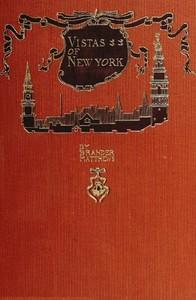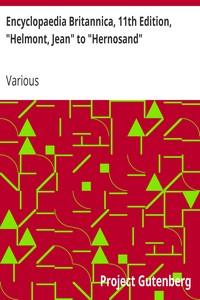|
|
Read this ebook for free! No credit card needed, absolutely nothing to pay.Words: 14553 in 5 pages
This is an ebook sharing website. You can read the uploaded ebooks for free here. No credit cards needed, nothing to pay. If you want to own a digital copy of the ebook, or want to read offline with your favorite ebook-reader, then you can choose to buy and download the ebook.

: Punch or the London Charivari Vol. 105 November 11 1893 by Various Burnand F C Francis Cowley Editor - English wit and humor Periodicals Punch@FreeBooksWed 07 Jun, 2023 Sheyichbi and its People 9 The Lenni Lenape and their Customs 10 Arrival of the Dutch 13 Wampum 14 The Relations of the Delawares with the Whites 16 Indian Names of Localities 16 Pavonia 18 Massacre of Indians 19 Indian Troubles 20 Communipaw 22 The First Ferry 23 The First Roads 24 Bergen 25 Bergen Court 27 The First Schoolmaster 27 School Houses 28 Early Ministers 30 The First Church, 31 The First Pall 33 The First Communion Set 33 The Second and Third Churches 35 Early Church Customs 35 The Voorleezer 37 Church Funds 38 Marriages and Town Poor 40 Burial Customs 41 Cemeteries 44 Paulus Hook 47 Paulus Hook Ferry 47 Revolutionary Period 50 The Battle of Paulus Hook 53 Lafayette in Bergen 57 Sergeant Champe 60 Bergen Patriots 61 Early Customs 64 New Years 64 General Training 65 Early Dutch Recipes 67 Cooking by Open Fires 69 Spinning and Weaving 71 Candle-making 72 Slavery 74 Lotteries 74 Jersey City 75 Municipal Changes 75 Forming the City 77 Newark Turnpike 78 Robert Fulton 80 The Ferries 81 Edge's Windmill 85 City Hall and Schools 87 Public School No. 1 88 Scholarships 89 Post Office 91 Churches 92 Business Interests 94 Jersey City Pottery 95 Fire and Police Departments 99 Hudson County Bar 99 Street Lighting 100 Railroads 101 Steamships 102 Street Railways 103 Waterworks 105 War Records: Army 107 Navy 110 Militia 111 Hospitals and Churches 117 The Clubs 120 Libraries 130 Parks 133 The City of To-day 135 The Old Houses 136 The City of the Future 143 FROM THE MINUTES OF THE LITERATURE COMMITTEE OF THE WOMAN'S CLUB OF JERSEY CITY. At a meeting of the Committee January 5th, 1898, one of the subjects for the day was "Jersey City's Old Landmarks." In the discussion that followed, Miss M. Louise Edge moved that Mrs. Eaton be requested to write a short history of Jersey City, to be published by the Club: the proceeds of which to be used to erect memorial tablets on historic sites of the Colonial and Revolutionary periods. At the meeting of October 12th, 1898, Mrs. Eaton made the following report: I take pleasure in reporting that in accordance with the request of this Committee embodied in the motion made by Miss M. Louise Edge upon January 5th, 1898, I have prepared the story of Jersey City. My authorities have been: Winfield's History of Hudson County, The Jersey City Journal's History of Jersey City, Colonial and City Records, Versteeg's Translation of the Deacons Accounts of the Bergen Church, Taylor's Annals of the Classis and Township of Bergen, and numerous descendants of the old colonial families,--the Van Reypens, Van Horns, Van Winkles, Sips, Newkirks and many others, to all of whom I am greatly indebted. Also to Dr. Brett, who has kindly assisted me with his great store of historic data. I wish particularly to express my great indebtedness to Mr. C. C. Van Reypen, who, with his wonderful memory and knowledge of Bergen, has been of invaluable assistance to me. Respectfully submitted, Harriet Phillip Eaton SHEYICHBI AND ITS PEOPLE. Before the white race came to America, the locality now known as Jersey City, was occupied by a branch of the Minsi division of the Lenni Lenape Nation of the Red Men, and was called Sheyichbi. The whole of the present state of New Jersey belonged to the Lenape, and was occupied by bands bearing different names according to the special features of the locality, but all recognizing their unity as one people. Those who lived here, along the western shore of the New York Bay, extending to the sea, were known as the Wapings, or Pomptons, and were the first of the Lenape to meet the white man when Verrazano visited this harbor in 1524. Their last home was along the Raritan river. The name Lenni Lenape means "Men of our Nation," and they claimed to be the oldest nation and root of the great Algonkin stock, which, in its various divisions, with forty distinct dialects, occupied this continent from Hudson's Bay to South Carolina, and from the Atlantic to the Mississippi and the great plains, with the exception of a portion east of the Lakes where the Huron Iroquois dwelt. The other Algonkin nations were spoken of by them as "children," "Grandchildren," or "younger brothers," and to them was always accorded the respectful title of "grandfathers." Their traditions taught them that they came from Shinaki, the "Land of the Fir Trees," which was probably north of Lake Superior, and in their migrations they came upon the Cherokees, probably in the ninth or tenth century of our era, with whom they fought one hundred years for possession of the Ohio Valley. Finally the Cherokees went south and the Lenape eventually, in the eleventh or twelfth century, made their home in the mountainous region of the head waters of the Delaware river. Their hunting grounds included lands now in Pennsylvania, New York and New Jersey. In 1758, New Jersey paid them ,000 for their lands in this State. They were called by the western nations Wapenachki,--"People of the Rising of the Sun." The name Delaware was given to them and one of their rivers, after Lord de la Ware, which they at first resented but accepted it after being told that he was a great "Brave." In character they were a noble spirited but gentle, kindly people, and all the early writers concur in testimony to their hospitality. Each family lived in its separate wigwam, a wattled hut with rounded top, thatched with mats woven of corn leaves, sweet flag, or bark of trees. These were built in groups and usually surrounded with palisades of small tree trunks firmly planted in the ground, sometimes two or three rows, interlaced, and from twenty to thirty feet in height. Their clothing was made of deer skin, soft and pliable and beautifully embroidered with wampum beads or dyed porcupine quills. In some of the arts they had attained great skill, excelling in dressing deer skins and in feather work; carved stone, made ornaments of shell and a rude pottery, some in the shape of animals. They recognized the value of the Trenton clays and Indian potters used them for centuries before the white men came. While their weapons and utensils were principally of stone, they also used copper, both native New Jersey ore and that brought from Lake Superior, which they deftly hammered into shape. Old mining holes and Indian tools have been found between Elizabethtown and New York. Bowls were carved from wood and from soap-stone, kettles were made of the latter which would hold from ten to twelve gallons. They used both vegetable and mineral paints and dyes; were very expert fishermen and hunters. They were accurate in computing time and had some astronomical knowledge; women and children could give names to many of the stars, and their year began with the first moon after the February moon. The time for planting was calculated by the rising of Taurus in a certain quarter. To this constellation they gave the name of a mythical great horned beast. They had a word for year, and counted their ages and sequence of events by yearly periods, but recognized only twelve moons in the year. They kept a record of the years by adding a black bead of wampum for each year in a belt kept for the purpose. Their picture writing was scratched on stones or cut or painted on bark or wood. It was a record of current events, the past history of the nation, and in memory of famous men, events, and actions of note. They also recorded abstract ideas, as, when an Indian gave William Penn a drawing of the "Great Man" within a series of concentric circles as their idea of God. These picture writings were understood and could be read by the various branches of the Algonkin stock. Bunches of slender sticks notched or painted were also used as records. Free books android app tbrJar TBR JAR Read Free books online gutenberg More posts by @FreeBooks
: Kansakoulu-opettajan nuoruudenvaiheet by De Amicis Edmondo - Schools Fiction; Teachers Fiction; Italy Social life and customs 19th century Fiction; Italian fiction Translations into Finnish@FreeBooksWed 07 Jun, 2023

: A Gamble with Life by Hocking Silas K Silas Kitto - Fiction; Suspense fiction@FreeBooksWed 07 Jun, 2023
|
Terms of Use Stock Market News! © gutenberg.org.in2025 All Rights reserved.






